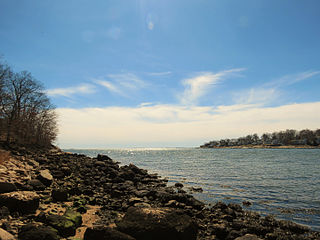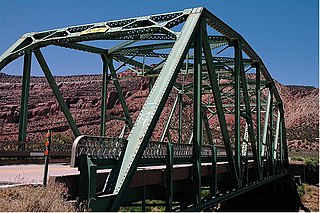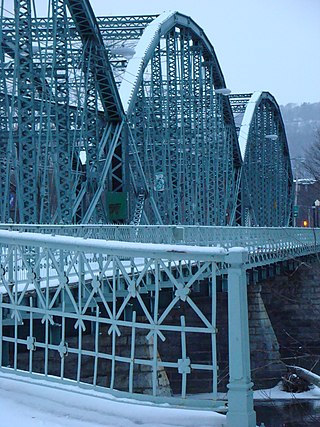
Jay is a town in Essex County, New York, United States. The population was 2,506 at the 2010 census. The town is named after John Jay, governor of New York when the town was formed.

Multnomah Falls is a waterfall located on Multnomah Creek in the Columbia River Gorge, east of Troutdale, between Corbett and Dodson, Oregon, United States. The waterfall is accessible from the Historic Columbia River Highway and Interstate 84. Spanning two tiers on basalt cliffs, it is the tallest waterfall in the state of Oregon at 620 ft (189 m) in height. The Multnomah Creek Bridge, built in 1914, crosses below the falls, and is listed on the National Register of Historic Places.

Wahkeena Falls is a 242-foot (74 m) waterfall in the Columbia River Gorge in the state of Oregon.

Rocky Neck State Park is a public recreation area on Long Island Sound in the town of East Lyme, Connecticut, United States. The state park's 708 acres (287 ha) include a tidal river, a broad salt marsh, white sand beaches, rocky shores, and a large stone pavilion dating from the 1930s. It is managed by the Connecticut Department of Energy and Environmental Protection.

Jefferson Avenue Footbridge is a historic footbridge located in Springfield, Missouri, United States. Built in 1902, it measures 562-foot (171 m) long and allows pedestrians to cross 13 sets of railroad tracks.
Thompson's Lake State Park is a 308-acre (1.25 km2) state park located near East Berne in Albany County, New York.

The Walkway over the Hudson is a steel cantilever bridge spanning the Hudson River between Poughkeepsie, New York, on the east bank and Highland, New York, on the west bank. Built as a double track railroad bridge, it was completed on January 1, 1889, and formed part of the Maybrook Railroad Line of the New York, New Haven and Hartford Railroad.

This is a list of sites in Minnesota which are included in the National Register of Historic Places. There are more than 1,700 properties and historic districts listed on the NRHP; each of Minnesota's 87 counties has at least 2 listings. Twenty-two sites are also National Historic Landmarks.

The Willimantic Footbridge is a pedestrian bridge in the Willimantic section of Windham, Connecticut. Built in 1906, it extends from Main Street southward, across Riverside Drive, railroad tracks, and the Willimantic River, connecting downtown Willimantic to the residential area south of the river. It is one of a small number of pedestrian bridges built in the early 20th century to survive in the state. It was listed on the National Register of Historic Places in 1979.

Honey Run Covered Bridge was a wooden covered bridge crossing Butte Creek, in Butte County, northern California in the United States. It was located on Honey Run Road at Centerville Road, about halfway in between Chico and Paradise, until it was destroyed in the Camp Fire on November 8, 2018.

Sudbrook Park is a historic neighborhood near Pikesville, Maryland located just northwest of the Baltimore City limits in Baltimore County.

Old Blenheim Bridge was a wooden covered bridge that spanned Schoharie Creek in North Blenheim, New York, United States. With an open span of 210 feet (64 m), it had the second longest span of any surviving single-span covered bridge in the world. The 1862 Bridgeport Covered Bridge in Nevada County, California, currently undergoing repairs due to 1986 flooding is longer overall at 233 feet (71 m) but is argued to have a 208 feet (63 m) clear span. The bridge, opened in 1855, was also one of the oldest of its type in the United States. It was destroyed by flooding resulting from Tropical Storm Irene in 2011. Rebuilding of the bridge commenced in 2017 and was completed in 2018.

Hyde Hall Bridge is a wooden covered bridge over Shadow Brook built in 1825, on then-private property of Hyde Hall, a country mansion. Both are now included in Glimmerglass State Park. With the possible exception of the Hassenplug Bridge in Pennsylvania, it is the oldest documented, existing covered bridge in the United States. The World Guide to Covered Bridges and its entries of both the National Register of Historic Places and the Historic American Engineering Record list it as being constructed in 1825. The Historic American Buildings Survey entry for it shows an 1830 erection date.

The Dolores River Bridge was a through truss bridge that spanned the Dolores River near Bedrock, Colorado, United States. It carried State Highway 90 and was listed on the National Register of Historic Places.

Wanakena is a hamlet located on the shore of Cranberry Lake in the town of Fine in St. Lawrence County, New York, United States. Tourism is a major industry in the area; a small year-round population is supplemented by an influx seasonal residents each summer. It is the location of the SUNY-ESF Ranger School.

The Skinners Falls – Milanville Bridge is a bridge spanning the Delaware River between Milanville, Pennsylvania, and Cochecton, New York, in Wayne County, Pennsylvania, and Sullivan County, New York. The bridge is 470 feet (140 m) long and holds one single lane of Skinners Falls Road, a local road. The bridge was constructed by the American Bridge Company and funded by the Milanville Bridge Company. The bridge replaced a ferry run by raftsman Daniel Skinner and his family. The bridge opened in 1902 and remained in service up until recently. It is one of several bridges in Sullivan County that are on the National Register of Historic Places, including the Roebling Aqueduct and Pond Eddy Bridge. The bridge is located with the Milanville Historic District.

South Washington Street Parabolic Bridge is a historic Lenticular truss bridge located at Binghamton in Broome County, New York. It was constructed in 1886 and spans the Susquehanna River. It is composed of three identical through trusses with an overall length of 484 feet. The bridge was closed to vehicular traffic in 1969. It is the longest multiple span, Lenticular truss bridge constructed in New York State during the 19th century. It was constructed by the Berlin Iron Bridge Company of East Berlin, Connecticut. It was listed on the National Register of Historic Places in 1978. The bridge was rehabilitated between 2014 and 2017.

Wanakena Presbyterian Church, also known as Mount Lebanon Presbyterian Church and Western Adirondack Presbyterian Church, is a historic Presbyterian church located at Wanakena in St. Lawrence County, New York. It was built in 1903 and is a "steepled ell" plan with its steepled entry tower located at the intersection of the two volumes. The tower has a louvered belfry topped by a pyramidal roof.

Raymondville Parabolic Bridge is a historic lenticular truss bridge located at Raymondville in St. Lawrence County, New York. It was constructed in 1886 and spans the Raquette River. It was constructed by the Berlin Iron Bridge Co. of East Berlin, Connecticut. It was closed to vehicular traffic in 1979 was used briefly as a pedestrian bridge. then closed completely to all traffic for safety reasons. There is now no public access to the bridge's actual deck, but both approaches are accessible on foot. There is a nearby similar but shorter version of this bridge also built by the Berlin Iron Bridge Co. still in use linking River Road and NY 56 at Yaleville, New York. In the late 1950s tragedy struck on the parabolic bridge. A small boy while walking to school one morning lost his footing and slipped on some ice and fell under the railing into the Raquette River where he drowned.

The Ronald Kirk Bridge is a pedestrian bridge over the Trinity River in Dallas, Texas. It connects Downtown Dallas and West Dallas, paralleling the 2012 Margaret Hunt Hill Bridge for vehicles, and the 1930 Texas and Pacific Railway Trinity River Bridge.























